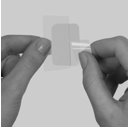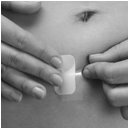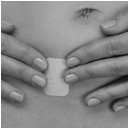Source: FDA, National Drug Code (US) Revision Year: 2020
Xulane is indicated for the prevention of pregnancy in women with a body mass index (BMI) <30 kg/m2 for whom a transdermal delivery system is an appropriate method of contraception.
Xulane may be less effective in preventing pregnancy in women who weigh 198 lbs. (90 kg) or more. Xulane is contraindicated for use in women with BMI ≥30 kg/m2 [see Contraindications (4), Warnings and Precautions (5.1) and Clinical Studies (14)].
To achieve maximum contraceptive effectiveness, Xulane must be used exactly as directed.
Complete instructions to facilitate patient counseling on proper system usage may be found in the FDA-Approved Patient Labeling.
The Xulane transdermal system uses a 28-day (4-week) cycle. A new patch is applied each week for 3 weeks (21 total days). Week 4 is patch-free. Withdrawal bleeding is expected during this time.
Every new patch should be applied on the same day of the week. This day is known as the “Patch Change Day”. For example, if the first patch is applied on a Monday, all subsequent patches should be applied on a Monday. Only one patch should be worn at a time.
Do not cut, damage or alter the Xulane patch in any way. If the Xulane patch is cut, damaged or altered in size, contraceptive efficacy may be impaired.
On the day after Week 4 ends, a new 4-week cycle is started by applying a new patch. Under no circumstances should there be more than a 7-day patch-free interval between dosing cycles.
The woman has two options for starting the patch and she should choose the option that is right for her:
Start contraceptive therapy with Xulane in women who elect not to breastfeed no sooner than 4 weeks after childbirth due to increased risk of thromboembolism. If a woman begins using Xulane postpartum, and has not yet had a period, consider the possibility of ovulation and conception occurring prior to use of Xulane, and instruct her to use an additional method of contraception, such as a condom and spermicide or diaphragm and spermicide, for the first 7 days [See Warnings and Precautions (5.1) and Pregnancy (8.1)].
After an abortion or miscarriage that occurs in the first trimester, Xulane may be started immediately. An additional method of contraception is not needed if Xulane is started immediately. If use of Xulane is not started within 5 days following a first trimester abortion, the woman should follow the instructions for a woman starting Xulane for the first time. In the meantime she should be advised to use a non-hormonal contraceptive method. Ovulation may occur within 10 days of an abortion or miscarriage.
Start Xulane no earlier than 4 weeks after a second trimester abortion or miscarriage, due to the increased risk of thromboembolic disease [See Contraindications (4) and Warnings and Precautions (5.1)].
Before applying the patch:
It may cause the patch to fail to stick properly or to become loose.
 | • The woman should tear open the pouch at the top edge and one side edge. She should peel open the foil pouch. She should gently remove the contents of the foil pouch and discard the additional pieces of film above and below the patch. |
 | • The woman should peel away half of the clear plastic. She should avoid touching the sticky surface with her fingers. |
 | • The woman should apply the sticky side of the patch on the skin she has cleaned and dried. She should then remove the other half of the clear plastic and attach the entire patch to her skin. |
 | • The woman should press firmly on the patch with the palm of her hand for 10 seconds, making sure that the whole patch adheres to her skin. • She should run her fingers over the entire surface area to smooth out any “wrinkles” around the outer edges of the patch. |
The patch must stick securely to the skin to work properly. If the Xulane patch becomes partially or completely detached and remains detached, insufficient drug delivery occurs. The woman should not try to reapply a patch if it is no longer sticky, if it has become stuck to itself or another surface, or if it has other material stuck to it.
If a patch edge lifts up:
If the patch has been off or partially off:
Under no circumstances should there be more than a 7-day patch-free interval between cycles. If there are more than 7 patch-free days, THE WOMAN MAY NOT BE PROTECTED FROM PREGNANCY and back-up contraception, such as a condom and spermicide or diaphragm and spermicide, must be used for 7 days. As with combined oral contraceptives, the risk of ovulation increases with each day beyond the recommended drug-free period. If she has had intercourse during such an extended patch-free interval, consider the possibility of pregnancy.
If the woman wishes to change her Patch Change Day, she should complete her current cycle, removing the third Xulane patch on the correct day. During the patch-free week, she may select an earlier Patch Day Change by applying a new Xulane patch on the desired day. In no case should there be more than 7 consecutive patch-free days.
In the event of unscheduled or breakthrough bleeding or spotting (bleeding that occurs on the days that Xulane is worn), treatment should be continued. If unscheduled bleeding persists longer than a few cycles, consider causes other than Xulane.
If the woman does not have scheduled or withdrawal bleeding (bleeding that should occur during the patch-free week), she should resume treatment on the next scheduled Change Day. If Xulane has been used correctly, the absence of withdrawal bleeding is not necessarily an indication of pregnancy. Nevertheless, consider the possibility of pregnancy, especially if absence of withdrawal bleeding occurs in 2 consecutive cycles. Discontinue Xulane if pregnancy is confirmed.
If patch use results in uncomfortable irritation, the patch may be removed and a new patch may be applied to a different location until the next Change Day. Only one patch should be worn at a time.
Unscheduled bleeding, spotting, and amenorrhea are frequent reasons for patients discontinuing hormonal contraceptives. In case of breakthrough bleeding, as in all cases of irregular bleeding from the vagina, consider nonfunctional causes. In case of undiagnosed persistent or recurrent abnormal bleeding from the vagina, take adequate diagnostic measures to rule out pregnancy or malignancy. If pathology has been excluded, time or a change to another method of contraception may solve the problem.
Overdosage may cause nausea and vomiting, and withdrawal bleeding may occur in women. In case of suspected overdose, all Xulane patches should be removed and symptomatic treatment given.
Store at 20° to 25°C (68° to 77°F) [See USP Controlled Room Temperature].
Store patches in their protective pouches. Apply immediately upon removal from the protective pouch.
Do not store in the refrigerator or freezer.
Used patches still contain some active hormones. The sticky sides of the patch should be folded together and the folded patch placed in a sturdy container, preferably with a child-resistant cap, and the container thrown in the trash. Used patches should not be flushed down the toilet.
© All content on this website, including data entry, data processing, decision support tools, "RxReasoner" logo and graphics, is the intellectual property of RxReasoner and is protected by copyright laws. Unauthorized reproduction or distribution of any part of this content without explicit written permission from RxReasoner is strictly prohibited. Any third-party content used on this site is acknowledged and utilized under fair use principles.